Mis compañeros de ciclismo-brandy-barbacoa se pegan a la carretera principal, la N7 hasta Nuwerus. Pero después de un gran día por Leliefontein ayer, no puedo evitar dejar Garies para la tierra otra vez. Vía Lutzville, debo ser capaz de llegar a la costa dentro de dos días.
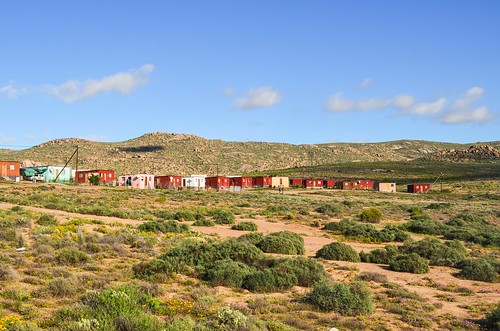
Fincas mira mucho menos elegantes que en Namibia. También están más cercanos de la carretera de grava. ¿Parecen más numerosos, así que tal vez cada finca tiene un terreno más pequeño que en Namibia? Tendría sentido, desde la precipitación, aunque ridículo comparado con el este del país, es todavía mucho mejor que en el Namib.
Lo que me dijeron antes sobre los caminos de tierra parece estar verificando: Namibia tiene muy pocas carreteras de alquitrán, pero la vasta red de carreteras de grava casi siempre está en excelentes condiciones. Por otro lado, Sudáfrica tiene un montón de carreteras de alquitrán de alta calidad, pero sus caminos de grava no parecen tan mantenidos como en Namibia.

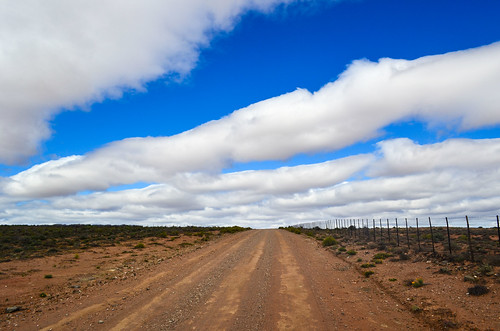
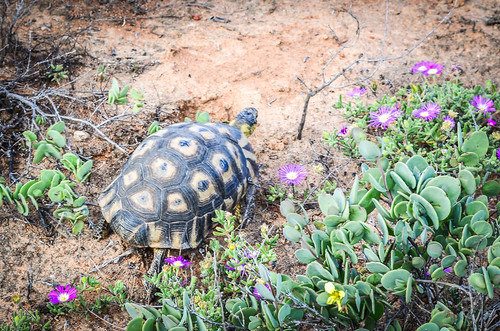
El camino no es tan interesante, y no hay nada realmente bonito. Mis varios mapas indican varias carreteras, y hay aún más caminos de tierra y pistas por ahí, es un poco confuso.
Además, la lluvia está empezando, hace frío y está húmeda, y no se siente como un día para estar afuera.
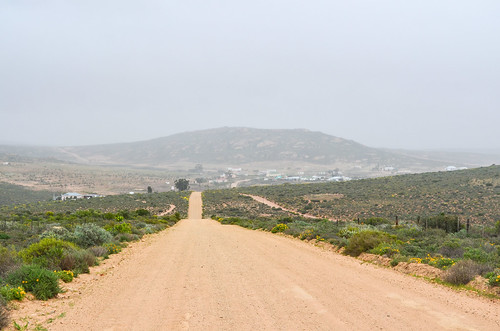
Kotzesrus is a small hamlet of people living from agricultural activities. I shelter under a roof of what seems the community central point, with a shop (closed), an old gas pump, and announcements on an environmental study concerning new mining projects in the area. I ask about the roads to a man passing by, and he tells me the sea is just 15 km away. What about all these roads in front of me and on my maps? Ah, they are the same, but one is going via donde vive la gente negra. It’s then similar to my encounter with the enorme población de Aussenkehr that was barely mapped, or to that location detrás de una colina en Twyfelfontein, el único lugar para comprar espaguetis dentro de 50 o 70 km, pero muy bien escondidos. Definitivamente hay un problema con la asignación de algunas áreas, que parece dejado deliberadamente fuera de zona de conocimiento del viajero. Tal vez es el más pequeño de los problemas de personas que viven en municipios y asentamientos informales, pero desde todos los caminos y todas las tiendas posibles y punto de agua es importante para mí, me lo afecta mucho.
Since the rain is not stopping, I accept Etienne’s invitation for a tea in the guesthouse he is setting up. Before that, the lady running that small community shop arrives, and not only can I buy a cold Coke, I can also luckily take some of the droëwors freshly made from game meat her husband went hunting in Namibia. It’s 100 rands for 1 kg, and it’s always useful!

Las paradas de lluvia ya no ganas de permanecer aquí más tiempo, pero prefieren utilizar el poco tiempo queda de luz para desplazarse más lejos. Etienne llama a un amigo suyo que tiene una casa de apartamentos 16 km de distancia, en mi dirección, y en que tierra pude configurar mi tienda. Es una buena idea, ya que no es tan fácil de "sueño en cualquier lugar" donde cada pedacito de tierra pertenece a una granja.
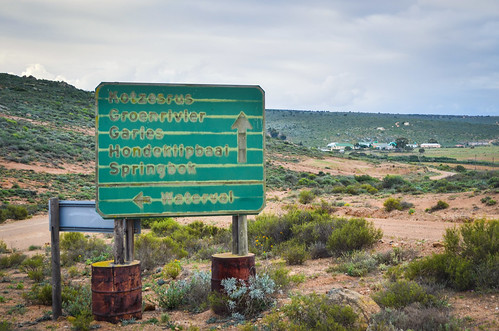
I know I compare Namibia and South Africa a lot, a bit like I compared West African countries together. Namibia and West South Africa are close enough in terms of climate and population density; Namibia was administered by apartheid’s South Africa until 1990; the social organization, the economy (diamonds, minerals and delicious meat), the people (Khoisan and European) have actually a lot in common, on a land that spans over a distance as big as Bordeaux-Budapest, Barcelona-Copenhagen, or Monrovia-Lagos.
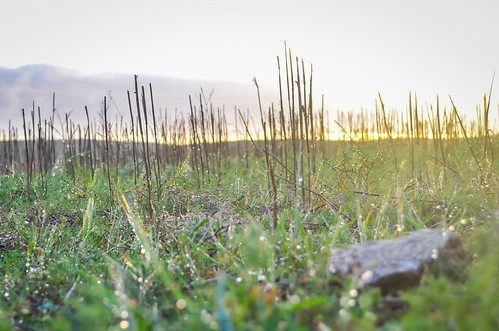

I get to see the sun again when it sets, and it’s so much nicer than a grey and flat land. But it’s almost night, and the rain has made the sand/gravel road sticky.
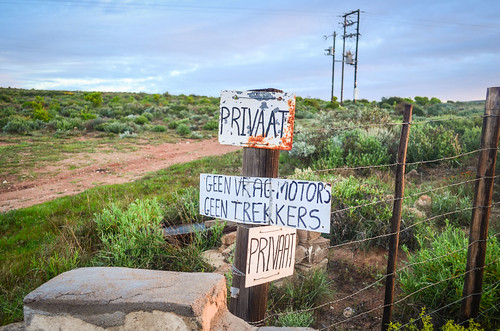

It’s finally night time and I’m still on the road. I told myself I should never end up cycling alone at night in South Africa, but here I am. That house mustn’t be really far … there is a last great downhill, during which I see many lights far, far away. Maybe a town for tomorrow. Helped with my bike lamp and headlamp, I finally get to that gate, and can start inspecting the buildings. The self-catering house is locked, the barn is entirely packed with hay, but I find a bit further a shed half in ruins … perfect!
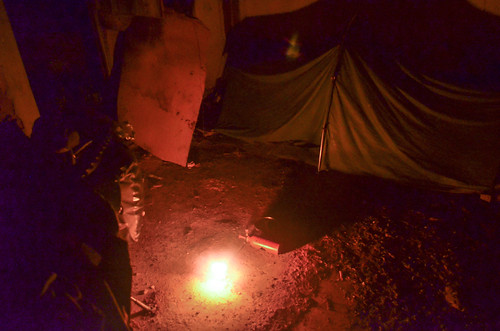
Perfect … or almost perfect, since a bird sneaked its way in and I can’t get it out. Considering the many bird poos on the floor, I’d rather build my tent so as to avoid waking up with a bad surprise in my hair.
And I sleep 12 hours in a row! I really needed a long night like this one after cycling with others. It’s simply not sustainable to cycle everyday and party or chat in the evenings.
I continue on my road of rural Western Cape. I’m approaching Cape Town (my destination is only 5 days away), but it still looks like Namibia: relatively good gravel, no cars at all, and a few farms and windmills. Except it’s green and massively cloudy. The clouds only change the whole experience, I have been treated with so much blue sky for so long in Namibia that I forgot there could be days when my camera sensor is unhappy.

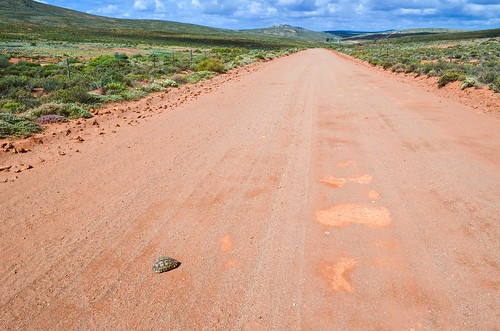

This railway is the Cape Town – Bitterfontein railway, used to carry ore from the Okiep copper mines, near Springbok. It didn’t look like a lot of activity is happening, but the railway has “fresh” tracks. I wonder what kind of trains run here and how often.
I am waiting to meet with theFerrocarril Sishen Saldanha, which is very exciting (for me), as the train running there is one of el más largo del mundo. It’s an iron ore train, just like the Mauritanian SNIM train carrying iron ore from the Zouerat/Fdérik mine, that He visto cerca del puerto de Nouadhibou. The Sishen-Saldanha railway must be close by.
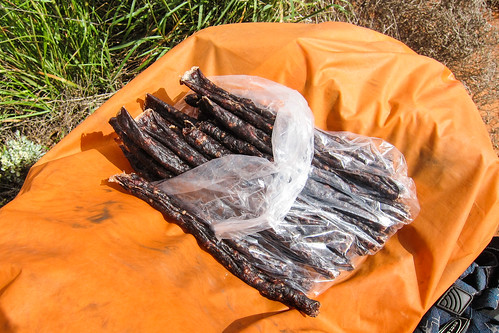

And suddenly, the tar reappears at a T-junction, with the Landplass station. A brand new tar road, still in the middle of nowhere. Trucks are coming from the east, on the coast, where a sign calls that place “Brand se Baai”, but I have nothing on my maps. It’s another “road paradox”, at the other end of the spectrum, balancing with the paradox of dirt roads leading to townships with a significant population. From my cycling experience, a nice tar road leading to nowhere, when there’s not so many tar roads around, is often linked to a mine.
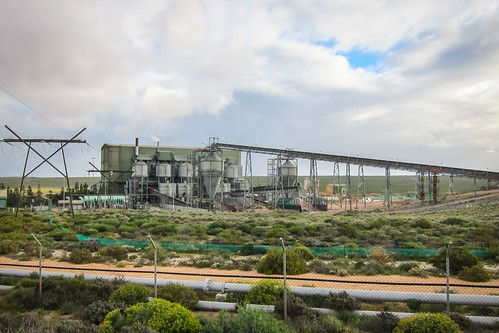
And a few kilometers further … Jackpot! A separation plant for the Exxaro-owned Namakwa Sands mine of Brand-se-baai, at the end of that tar road, which actually looks likeEsto.
The brand new tar means that my last 30 km to Lutzville will be fast. Lutzville is known for its vineyards. The town is located on the Olifants river, and from the vista de satélite, it seems the whole river is being used for agriculture.
Five kilometers before town, Amanda calls me. She is the cyclist Etienne told me about yesterday, and we had exchanged phone numbers. She says she’s staying on a farm near Lutzville, and I should make it there. I am already in the vineyards, but I’d need some time to complete the 10 remaining kilometers.
Sin embargo, mientras paso por la fábrica de tomates, un pick-up se detiene al otro lado de la carretera, y me dicen que suba. ¿Qué? ¿Cargar mi bicicleta y conducir? De ninguna manera, eso es hacer trampa, y estoy decidido a andar en bicicleta cada poco. Es extraño, en realidad, cuanto más progreso en mi viaje, y más me radicalizaré para hacer todo por mi cuenta. He tenido que hacer trampa cuatro veces hasta ahora, siempre en contra de mi propia voluntad, pero seguramente pedaleé unos cuantos miles de kilómetros adicionales para compensar las pocas docenas que mi moto no podía hacer. Amanda llama de nuevo, más o menos pidiéndome que no sea tan estúpida cuando envió a Jasper sólo por mí, y eso hace que mi 5a y última vez haga trampa para todo el viaje.
Estoy un poco molesto hasta que lleguemos a la granja de Jasper. No es realmente elegante, no hay agua corriente hasta algún momento en que fluye amarillo, pero mejor que el agua, ¡hay brandy y carne! "Estas son las mejores chuletas que se pueden degustar en Sudáfrica", dijo, y rápidamente resulta cierto. Bueno, cuando me tratan con un braai después de un día en la carretera, creo que tiendo a estar de acuerdo con bastante facilidad. Amanda es más o menos vivir en su bicicleta, por lo que también es muy fácil de conectar.
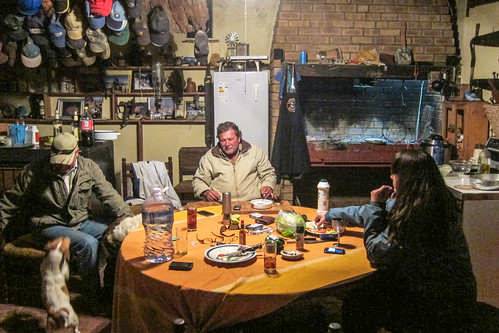
La hospitalidad afrikaner que he estado recibiendo hasta ahora en Sudáfrica es un poco increíble, como resultado no he dormido realmente fuera. Y siempre viene con un braai y carne hasta que se llena, que es básicamente lo que he estado soñando durante el último año. Algo sorprendente es que siempre he sido recibido por los blancos. ¿Dónde están los negros? De hecho, las negras (como en Bantu) la gente nunca ha vivido en la mitad occidental seca de Sudáfrica. Fue el hogar de la Khoisanhasta que los europeos se establecieron en Ciudad del Cabo, y progresivamente se apoderaron de la tierra. Hoy en día, el mapa de población dominante of South Africa still shows clearly the division, and that’s why I don’t see as many Black people as one could expect for Sub-Saharan Africa. The map defines the dominant population of the Northern Cape and the Western Cape as “Coloured”, as were called, during the apartheid, people not white enough, and not black enough (and also, not Indian)(so it leaves the Khoisan themselves, and the people resulting from natural mixing and re-mixing between the Khoikhoi, the Europeans, and the imported slaves)(if it doesn’t make sense, it’s normal).
By the way, anywhere in rural areas between Senegal and Angola, I would be called “White White White!” up to a hundred times a day, and possibly asked for a present, but after explaining that I am not a journalist and am just looking for food and water, it’s often that I ended up sharing a meal and offered a place to stay. In rural South Africa, nobody is calling me White or trying to get my attention, I guess because my whiteness is no more special, and possibly because whiteness is more associated with apartheid than with tourism or with Santa Claus. The only ones hosting me are the ones whiter than me. Amanda says that I’d have to cycle the Eastern Cape, to find a positive experience similar to the ones I had elsewhere in Africa.
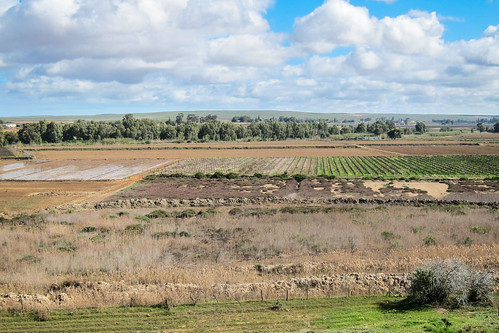
Si lo entendí bien, Jasper es el mayor productor de batata del país. La zona agrícola no es más grande que la granja promedio en Namibia, pero probablemente es más fácil de trabajar y parece producir mucho más. El problema es que no puede hacer planes a largo plazo, ya que tarde o temprano su tierra será confiscada y redistribuido. De hecho, Sudáfrica y la desigualdad son casi sinónimos.
Mi país anterior, Namibia, es el país donde la proporción de los ingresos medios del 10% más rico al 10% más pobre es la más alta del mundo. Sudáfrica casi está encabezando la lista mundial de países clasificados por índice Gini, que es una medida propuesta de desigualdad de ingresos or wealth. The mathematical function behind the Gini index is far too simple to account for the history, population diversity and growth of the countries studied, but it works rather well for one wondering “¿Dónde está el lugar más barato contratar a mi prójimo como a mi empleada doméstica“.
These two, plus Angola, Zambia and Botswana, are in the world’s top 10 worst Gini’s (Zimbabwe’s case can’t fit in the formula), while the Scandinavians are, as usual, at the other end of the spectrum. So it seems Southern Africans have a problem with sharing. It is to be noted, also, that independence in Southern Africa was obtained slightly later than the rest of the continent.
Back to farming now. Land ownership is one of the most obvious representation of inequality in South Africa, and a legado del apartheid. Still today, White South Africans, representing 9% of the population, own much more than 9% of the land. It’s actually hard to get the real numbers, as hard as it is to find scientific honesty when it comes to political matters. The government is currently taking the land from White farmers against a compensation, and giving it to black-run communities. It seems nice compared to ¿Qué Zimbabwe, but naturally it doesn’t make the White farmers happy. Among the nicest things that I could hear about Black South Africans, are “when they receive a farm for free, they would buy themselves a nice car instead of investing in tools and making plans, and eventually ruin it", o"usan bienestar para vivir de forma gratuita a los contribuyentes unos“. Fact-checked, it’s true that only 6% of the South African population pay taxes (compared to 51% in the USA or 46% in the UK). It’s also hard to pay taxes when you simply have no money.
It seems everything is, and has to be, about race. In more lighthearted comments, “the real rednecks are the British; an Afrikaner doesn’t sunburn, he knows how to deal with Africa", o"when it’s too cold in the Free State, the Afrikaner puts on two pairs of shorts“. The South African Whites can be “divided” into two sub-groups, theAfrikaners(like Charlize Theron), mostly of Dutch origin, with a few French Huguenots also on the boats, who first settled in 1652, and theBritánico(like the Princess of Monaco), in their colonial expansion, who joined the invasion some 150 years later. Of course they managed to fight against each other, even that far in the south.
I also hear a lot about how lazy South Africans are, and how Zimbabweans are much more hard-working. On the other hand, these same Zimbabweans are the first ones accused when a crime is reported. It reminds me that I’d have to cycle there, apparently in Botswana for the wildlife and the cheapest meat, and in Zimbabwe for its welcoming people. I could have forked east from Namibia, but I already wanted to finish and went straight south.
Despite the apparent technological predisposition of South Africa (the first human control of fire, the first heart transplantation, Ubuntu-Linux, plans for the futureTelescopio de radio SKA, and Elon Musk were made there), the richest men of the country are mostly into mining, and the top politicians are super rich and super corrupt. My takeaway is that, even if it’s hard to define South Africa as a first world or a third world country (it’s nowhere near as undeveloped as what I have seen further to the north), it has for sure both first world problems and third world problems. Besides that, the landscape is beautiful.
We leave the next day with Amanda, heading to the coast in the direction of Cape Town. She has cycled the area many times, so she knows a lot about the things to see.
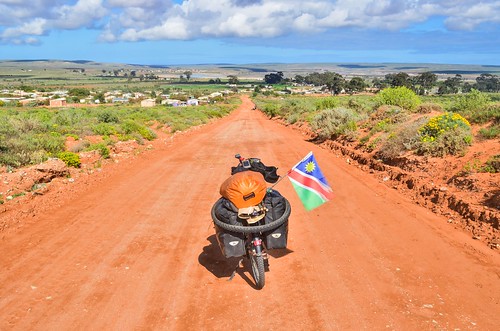

Tadam, the sea! I did well at avoiding it during the whole trip. Now we’re together until the end. The mouth of the Olifants river is just there, with a windmill farm in the background. It’s called Papendorp. Maybe I will see more of the Cape flowers from now on?

Amanda suggest we could enter the first coastal village of our road, Strandfontein. It looks like fancy holiday homes by the Atlantic Ocean. However, we’d have to go downhill and cycle up again … I was ready for that until she said one of the next villages has seafood and a wine estate. It’s not meat, but it still suits me.

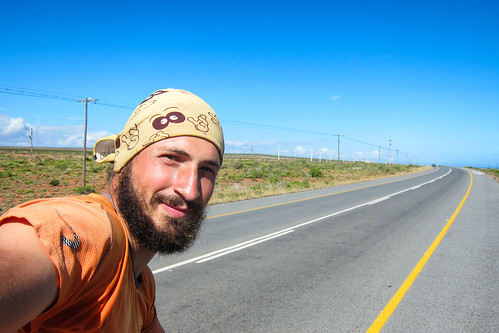
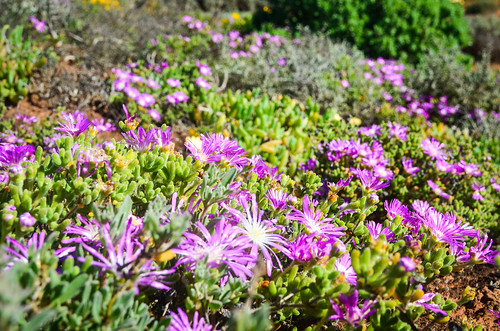

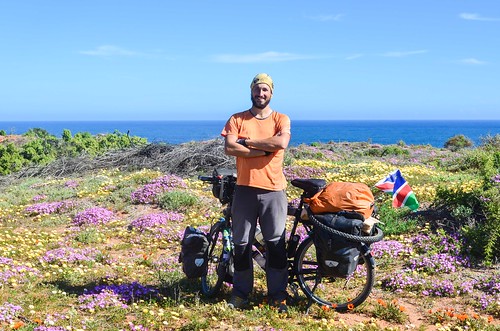
While posing in the flowers, I spot a whale! Just there! It’s being a very good day, and the best is still coming up. We reach Doringbaai, another coastal village, just after passing a vineyard on our left. It’s a tiny estate, and they don’t sell their wine in many places, but it’s possible to taste it at the restaurant on the pier, near the old crayfish factory. And we end up buying a bottle with our seafood.
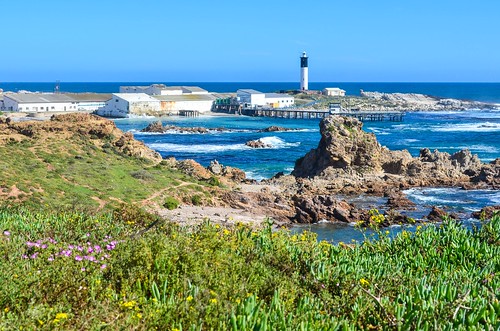
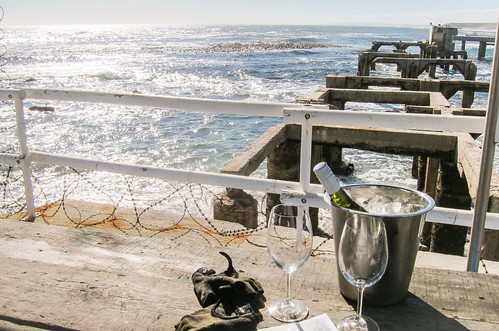
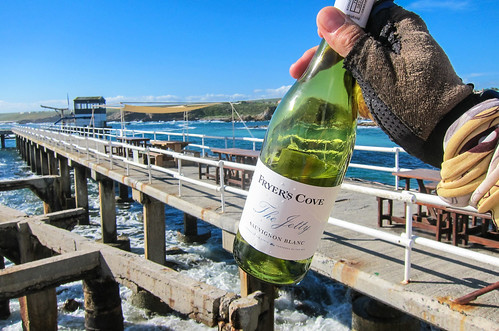
It feels strange, since my fanciest lunches on the road have been a plate of rice or some cassava-based meal. And today, we just need to stop with the same bike, same dirty gloves, and we can have real good food in a superb setting? Then why have I been touring Africa? Why did I do that to myself? That’s my initial reaction … but I know well that comfort quickly gets boring, and adventure is not found at the bottom of a wine bottle.



Our target for the day was Lambert’s Bay, the largest town on the coast, where Amanda has friends. But it’s 16:30, and we only cycled half the distance from Lutzville. Hmmm … not really smart, but not guilty either, since the stop in Doringbaai was worth it. Despite a bottle of wine in the legs, we decide to stick to the plan and see if we can reach Lambert’s Bay before night.

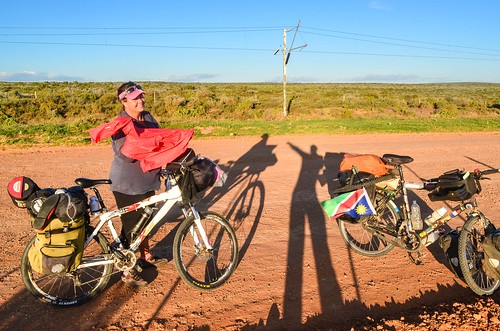
The 34 kilometers between Doringbaai and Lambert’s Bay are easily feasible, even if the map show the road R362 cut between the two places. The tar road is indeed stopping, but we can easily continue with the Transnet private road. It’s a dirt road always sticking close to the iron ore railway line, originally a service road, but now open to anyone. It allows to cut through nature reserves.
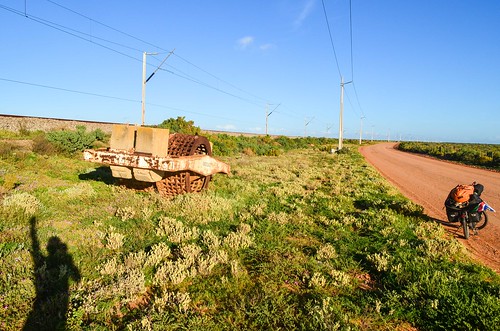

And finally, at the end of the day, the giant caterpillar shows up on the railway. The Sishen-Saldanha train once held the record of the longest train in the world, with 16 locomotives, 660 wagons and 7.3 km in length. It’s like if one train has wagons continuously filling up the rail track between Zürich HB and Schlieren. The only way to see it entirely is ir en el cielo. It runs 861 km from the Sishen/Kathu iron ore mine in the center of the country, to the port of Saldanha.

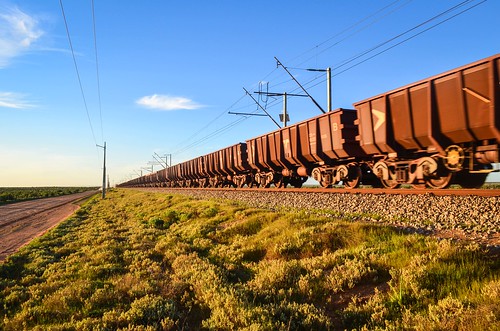

This train, that I catch on its way back from Saldanha, is a regular one: only 8 locomotives, 342 wagons, for a length of 3,780 meters. That’s long enough to try all the possible settings on the dSLR. I will be passing by Saldanha later to check it at the terminal.
Now, there is still 15 km to cycle at night. Fortunately, the service road is very quiet, and we have two powerful bike lamps. I still decide to wear my reflective jacket before entering Lambert’s Bay. It’s Friday night and the town is the largest coastal town of the area, with a whooping 6000 people.


That Transnet service road has gates from time to time. Despite being open and free, it’s still a private road and cars are being checked. But it’s really the best way to cycle north or south in Western Cape.
With little visibility, we finally reach the town where Karen and Marais, Amanda’s friends, welcome us, directly at the bar. Straight from night to light, and from peddling to drinking. We’re not dirty enough to need a a shower right away. Some of the music playing sounds like something I know … It’s old Afrikaans songs, but … do I really know it? It sounds exactly like Apres-Ski music! I was already finding Afrikaans and Swiss-German quite similar in how unsexy it can sound, and now I can’t help thinking about Esto.
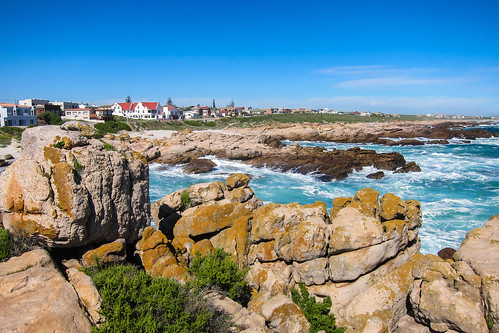
Marais is here a first name. As a last name, Wikipedia las listas más Marais in South Africa than in France. Without forgetting all the wrong things that White settlers have done to the people here, I find it interesting to notice some European heritage at the bottom of the world. Amanda will stay longer in Lambert’s Bay to delay her arrival in Cape Town where she doesn’t have a house yet, but I will get on the saddle tomorrow. I’m only 3 days away from my destination!
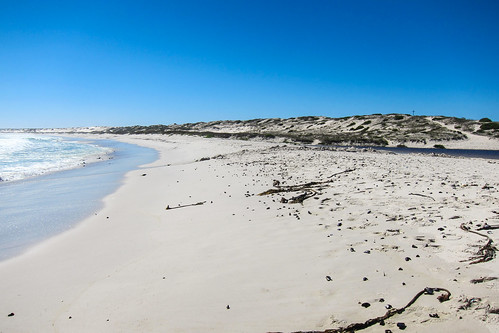

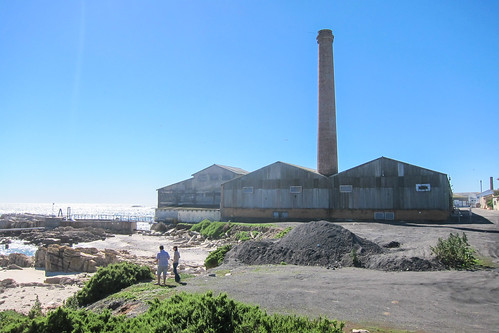
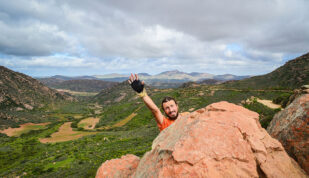
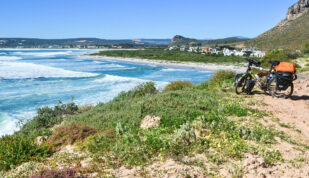

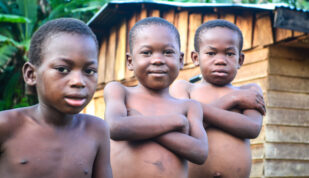

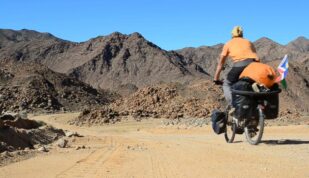
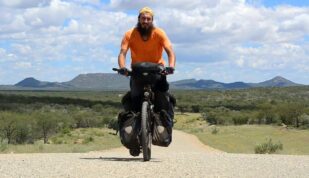
Contesta